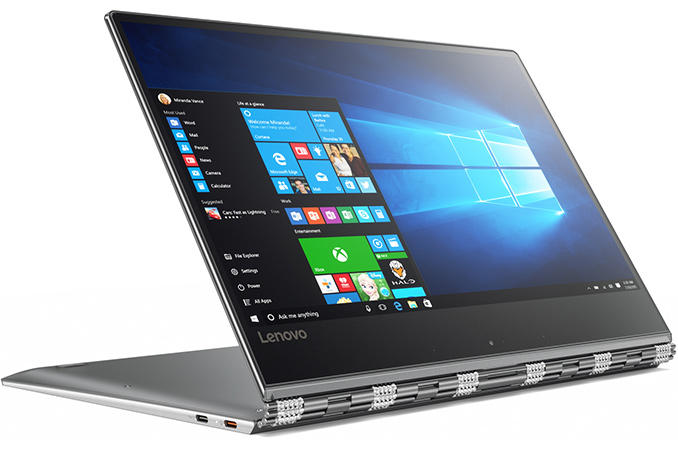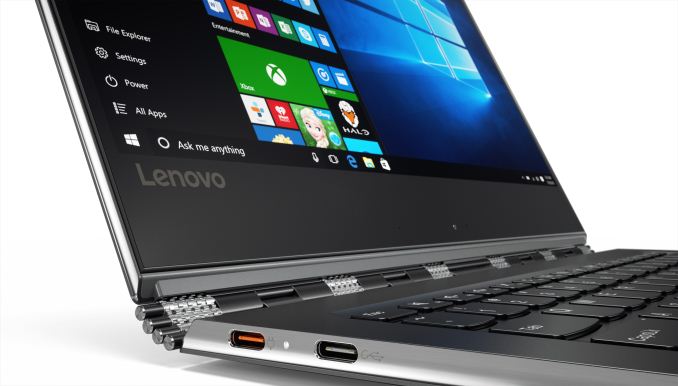Lenovo Reveals Yoga 910 Convertible: Intel’s Kaby Lake Meets 4K Display and Ultra-Thin Form-Factor
by Anton Shilov on September 2, 2016 10:00 AM EST
Lenovo this week took the wraps of its new Yoga 910 convertible, an aluminium 2-in-1 equipped with a 4K UHD display and is based on Intel’s upcoming 7th generation Core processors codenamed Kaby Lake. The Yoga 910 inherits distinctive form-factor from the previous-gen Yoga 900 laptops, makes it slightly thinner and adds a fingerprint reader to the familiar design.
The Lenovo Yoga 910 is the direct successor of the Yoga 900 introduced last year, which at present is Lenovo’s top-of-the-range offering in the Yoga lineup. The new Yoga 910 will not only offer higher performance (something that is logical to expect from a PC based on a newer CPU), but also a slightly larger 13.9” IPS display panel with either 4K (3840×2160) or FHD (1920×1080) resolution. Thanks to thinner bezel, the larger screen does not affect dimensions of the convertible, and in fact the new model is even a little smaller and thinner (14.3 mm vs 14.9 mm) than its predecessor. Still, it is noteworthy that the Yoga 910 weighs 1.38 kg (3.04 lbs), which is around 80 grams more than the weight of the Yoga 900. When it comes to battery life the UHD model can offer 10.5 hours on one charge (in line with current models that have 3K displays), whereas the FHD promises to work for up to 15.5 hours (which is a massive improvement over current SKUs).
| Lenovo Yoga Specifications | |||||
| Yoga 3 Pro | Yoga 900 | Yoga 910 | |||
| Processor | Intel Core M-5Y71 (4.5W) | Intel Core i7-6500U (15W) | Intel Core i7-7000 series | ||
| Memory | 8GB DDR3L-1600 | 8-16GB DDR3L-1600 | Up to 16 GB | ||
| Graphics | Intel HD 5300 (24 EUs, Gen 8) |
Intel HD 520 (24 EUs, Gen 9) |
Intel HD Graphics | ||
| Display | 13.3" Glossy IPS 16:9 QHD+ (3200x1800) LCD |
13.3" Glossy IPS 16:9 QHD+ (3200x1800) LED |
13.9" 4K (3840 x 2160) IPS 13.9” FHD (1920x1080) IPS |
||
| Hard Drive(s) | 256GB/512GB SSD (Samsung PM851) |
256GB/512GB SSD (Samsung ?) | Up to 1 TB PCIe SSD | ||
| Networking | Broadcom 802.11ac (2x2:2 802.11ac) |
Intel Wireless AC-8260 (2x2:2 802.11ac) | 2x2:2 802.11ac | ||
| Audio | JBL Stereo Speakers 1.5w x 2 Headset jack |
JBL Stereo Speakers Dolby DS 1.0 Headset jack |
JBL Stereo Speakers with Dolby Audio Premium Headset jack |
||
| Battery | 4 cell 44Wh 40W Max AC Adapter |
4 cell 66Wh | Unknown | ||
| Buttons/Ports | Power Button Novo Button 2 x USB 3.0 Headset Jack Volume Control Auto Rotate Control DC In with USB 2.0 Port 1 x Micro-HDMI SD Card Reader |
Power Button 2 x USB 3.0-A 1 x USB 3.0-C Headset Jack SD Card Reader DC In with USB 3.0-A Port |
Power Button 1 x USB 3.0-A 1 x USB 3.0-C 1 x USB 2.0-C for charging Headset Jack |
||
| Back Side | Watchband Hinge with 360° Rotation Air Vents Integral to Hinge |
||||
| Dimensions | 13" x 9" x 0.5" 330.2 x 228.6 x 12.8 mm |
12.75" x 8.86" x 0.59" 324 x 225 x 14.9 mm |
12.72" x 8.84" x 0.56" 322 x 224.5 x 14.6 mm |
||
| Weight | 2.6 lbs (1.18kg) | 2.8 lbs (1.3 kg) | 3.04 lbs (1.38 kg) | ||
| Extras | 720p HD Webcam Backlit Keyboard |
||||
| Colors | Light Silver Clementine Orange Golden |
Platinum Silver Clementine Orange Champagne Gold |
Platinum Silver Champagne Gold Gunmetal |
||
| Pricing | $1148 (256GB) $1379 (512GB) |
$1200 (8GB/256GB) $1300 (8GB/512GB) $1400 (16GB/512GB) |
Starting from $1299 | ||
Lenovo has not revealed the complete specifications of the Yoga 910 just yet, but they note that it will use Intel’s Core i7 "Kaby Lake" 7000-series CPUs, up to 16 GB of RAM, a PCIe SSD (with up to 1 TB capacity) and will be equipped with a 802.11ac Wi-Fi + Bluetooth 4.1 module, a 720p webcam, a dual-array microphone, two speakers made by JBL, as well as a fingerprint reader compatible with Windows Hello. For wired connectivity, the Yoga 910 has one USB 3.0 Type-C with video out functionality, one USB 2.0 Type-C for charging as well as one USB 3.0 Type-A port with always-on charging capability.
When Lenovo’s Yoga 910 laptops hit the market in October, they will be available in Champagne Gold, Platinum Silver and Gunmetal colors. Apparently, Lenovo is dropping its signature Clementine Orange color it uses for consumer notebooks in case of the Yoga 910. As for prices, the new convertibles will start at $1299, which is a $100 increase over current-gen models.
Source: Lenovo

















39 Comments
View All Comments
mkozakewich - Tuesday, September 6, 2016 - link
IF manufacturers decided to keep the exact number of pixels when moving from 16:10 to 16:9, then all those arguments about things like video size would be valid.There's literally no difference between a 16:9 video on a screen of 16:9 or 16:10, though. They have the exact same pixel count across. All 16:9 means is you don't get as many pixels, and that's really annoying to a lot of people.
cocochanel - Friday, September 2, 2016 - link
Why would anyone need a 4k display only 14 inches in size ? Can anyone tell me ? What can you use it for ? The other day I was in a BestBuy store looking at a Surface Book. Because of the high resolution display, one can hardly see the fonts.retrospooty - Friday, September 2, 2016 - link
Windows resolution scaling sucks, especially with ultra high res, so it isnt very useful when used as a standard laptop... However, when used as a tablet, you tend to hold it alot closer. That res is good if you have good eyes and want a perfectly clear picture... However, again, windows sucks as a tablet, so I dont know... If someone really needed a convertible one device fits all, like this or a surface, this is a great product though.Black Obsidian - Friday, September 2, 2016 - link
4K is also a lot more flexible than the previous 3200x1800, in that it can do 2:1 scaling for an apparent 1920x1080 for desktop work--about the highest resolution you'd want in that scenario, IMO, but still do native 4K for applications/media that would benefit.MattCoz - Sunday, September 4, 2016 - link
Yeah, anything other than 2:1 scaling can look pretty bad with thin lines getting blurred, so this is great.Ej24 - Sunday, September 11, 2016 - link
If only there was some resolution that was 16:9 and also 1/2 of 3200x1800...Seriously though, 16:9 is only ok for phones. Anywhere else we need 16:10 or taller. Trying to write or read long documents on 16:9 is terrible. Between the task bar and the ribbon on word it leaves you with about 3 inches of vertical space and 12 inches of horizontal.
Tams80 - Friday, September 2, 2016 - link
Windows doesn't suck as a tablet other than at scaling.retrospooty - Saturday, September 3, 2016 - link
I suppose its a matter of opinion, but I would say it's several stages beyond suck. I would also say the market agrees, as there really arent any that sell well.nikon133 - Monday, September 5, 2016 - link
It is not as bad as it used to be. I'm using Surface Pro 4 a lot these days, at default scaling... I think it is 200%? So far, only Photoshop CS5 looks horrendous, as it doesn't accept scaling at all... but CS5 is a few years old already, so hopefully new Photoshop scales better? Everything else I'm using does OK. Old programs GUI gets that blurry look, but it is at least usable. Newer programs and apps scale fine.But yeah, definitely space for improvements. But I think it will be more down to developers updating their software and following modern guidelines, than MS themselves.
HStewart - Wednesday, January 23, 2019 - link
Using the following link you can fix scaling on CS5, I don't care for new subscription Photoshops and sticking to CS5Just search for "Adobe App Scaling on High DPI Displays (FIX)"